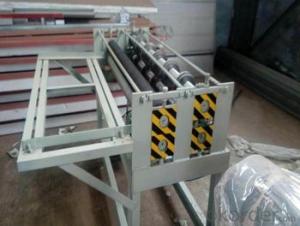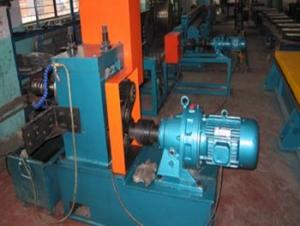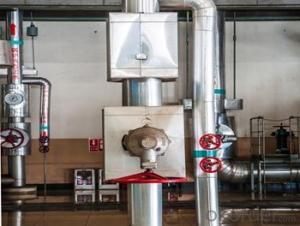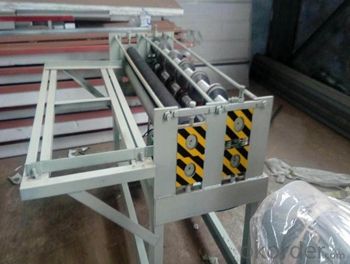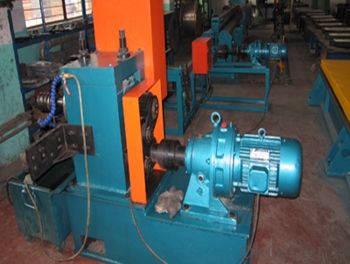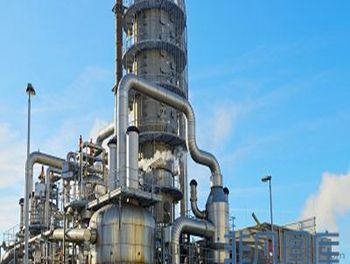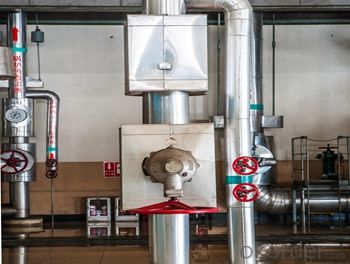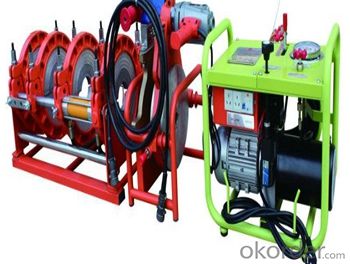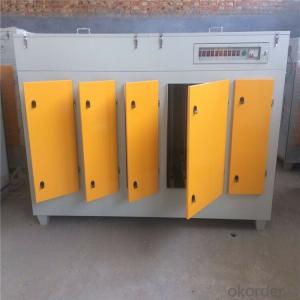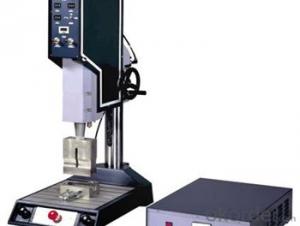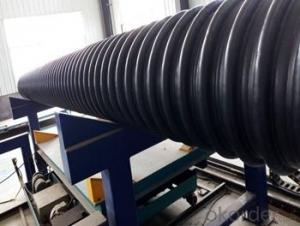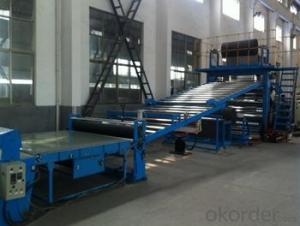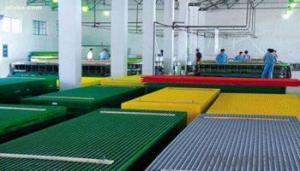FRP Pultrusion Profiles - Non-Toxic High Strength FRP Pultruded Grating
- Loading Port:
- Tianjin
- Payment Terms:
- TT OR LC
- Min Order Qty:
- 2 m.t.
- Supply Capability:
- 50000 m.t./month
OKorder Service Pledge
OKorder Financial Service
You Might Also Like
FRP PULTRUDED GRATING AND PULTRUSION PROCESS
PRODUCT DESCRIPTION
Pultruded grating is made by a particular assembly process, which using “I” shape as its main load-bearing and special rod to go through the bearing bar. Pultruded grating include the standard grating and the custom grating, the custom grating can be designed to meet customer’s requirement or special using condition by changing the shape, size and space of the bearing bars, the surface can be covered with lozenge panel, grit panel, or added the anti-slippery sand directly.
FRP pultruded grating has the most characteristics of molded grating, but it has its distinct advantages, it has very high fiberglass content in the loading direction, so it has very high load capability, it has more superiority when used at wide span, so that the basic support will be decreased and the project cost will be reduced accordingly.
SPECIFICATION
The standard space between two crossbars is 6 inch or 12 inch.
Thickness (mm) | Bar width (mm) | Open space (mm) | Open rate (%) | Approx weight (kg/m |
25.4 | 15.2 | 22.8 | 60 | 13.2 |
25.4 | 15.2 | 15.2 | 50 | 15.9 |
25.4 | 15.2 | 10.1 | 40 | 18.5 |
25.4 | 40 | 10.8 | 21 | 14.5 |
38.1 | 15.2 | 22.8 | 60 | 15.8 |
38.1 | 15.2 | 15.2 | 50 | 19.1 |
38.1 | 15.2 | 10.1 | 40 | 22.4 |
50.8 | 25.4 | 25.4 | 50 | 16.6 |
50.8 | 25.4 | 12.7 | 33 | 21.1 |
CHOICE FOR PULTRUDED GRATING
Resin: GP resin, ISO resin, VE resin, Phenol resin
Color choice: Yellow, gray, green, custom color
Surface choice: Groove surface, grit surface, lozenge cover surface
FEATURES
a. Anti-corrosion and anti-rust
b. Light weight and high strength
c. Anti-flammable
d. Anti- fatigue
e. Safe and anti-slippery
f. Anti-ageing
g. Easy of maintenance
h. Excellent electromagnetism property
i. Good economic benefit
APPLICATION
Operation terrace,
stair walkway,
ground floor,
trench cover,
sidewalk,
foot bridge,
equipment safety fence,
scaffold.
COMPANT DESCRIPTION
CNBM,China National Building Materials Group is a state-owned enterprise in charge of administrative affairs in china building materials industry. Established in 1984, CNBM is a large group corporation of building materials with total assets of 25 billion RMB and a total staff of 30,000.CNBM now owns 200 subordinating firms of solely owned and joint-venture companies.
CNBM International Corporation is one subsidiary of CNBM, we focus on offering good-quality products,professional service and complete solution to our customers. Strong delivery capacity, advanced technology& management, strong financing capability and excellent after-sale service are our advantages in sharing international market.
FAQ
1.Q:Are you factory or trading company ?
A:We are Factory produce FRP machines and FRP products.
2.Q:If can customized by customers requirements?
A:yes,we can produce the machine with customized size.
3.Q:How about the payment?
A:We accept any kind of payment.
4.Q:What is the guarantee?
A:Gurantee is one year.
5.Q:If you can training?
A:yes ,we can training in our factory also can send engineers to your factory training.
PICTURES
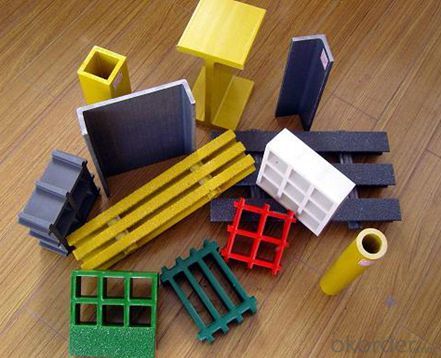
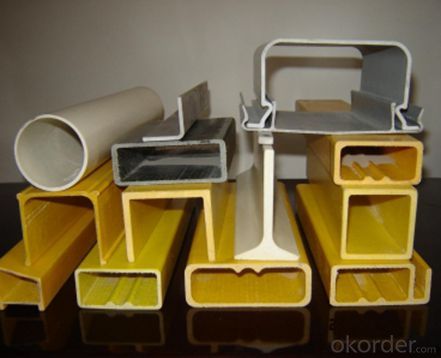
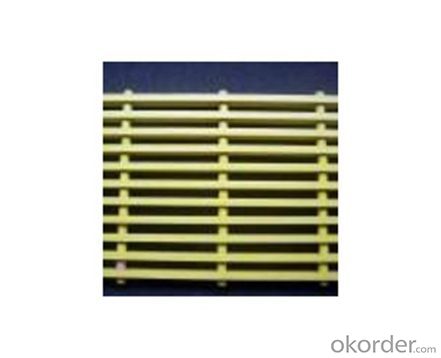
- Q: Can FRP pultrusion profiles be used in the construction of wind turbine blades?
- Yes, FRP (Fiber Reinforced Plastic) pultrusion profiles can be used in the construction of wind turbine blades. These profiles offer high strength-to-weight ratio, excellent corrosion resistance, and can be custom-designed to meet the specific requirements of wind turbine blade construction. Additionally, FRP pultrusion profiles provide flexibility in design and can withstand the demanding conditions of wind turbine operation, making them a suitable choice for blade construction.
- Q: What is the compression strength of FRP pultrusion profiles?
- The compression strength of FRP pultrusion profiles can vary due to several factors, including the type of resin, fiber orientation, and design. However, on average, the compression strength of these profiles ranges from 10,000 to 50,000 psi. It is worth mentioning that these values are approximate and may differ depending on the specific application and intended use of the FRP profiles. Moreover, manufacturers usually offer technical data sheets that detail the compression strength and other mechanical properties of their FRP pultrusion products. These sheets can be used to obtain more precise and dependable information.
- Q: What is the shear strength of FRP pultrusion profiles?
- The shear strength of FRP pultrusion profiles can vary due to multiple factors, including the quality and type of fibers, the resin matrix, and the manufacturing process. FRP pultrusion profiles generally possess high shear strength because of the continuous fibers that run along their length. To determine the shear strength of FRP pultrusion profiles, industry standards like ASTM D2344 or ISO 14129 are commonly employed for testing. These tests involve subjecting the profile to a shear force until it fails, allowing for the calculation of shear strength. The exact shear strength values for FRP pultrusion profiles can differ significantly based on their specific composition and design. However, it is not uncommon for these profiles to exhibit shear strengths of 50-150 MPa or higher. Consequently, they are suitable for a broad range of structural applications that involve shear forces. It is worth noting that the shear strength of FRP pultrusion profiles can be affected by factors such as temperature, moisture, and exposure to chemicals. Therefore, it is crucial to consider the environmental conditions and application requirements when selecting the appropriate FRP profile. Overall, FRP pultrusion profiles are renowned for their exceptional shear strength, which contributes to their widespread use and effectiveness in industries like construction, transportation, and infrastructure.
- Q: Can FRP pultrusion profiles be used in the oil and gas industry?
- Yes, FRP (Fiber Reinforced Polymer) pultrusion profiles can be used in the oil and gas industry. FRP pultrusion profiles offer several advantages that make them suitable for applications in this industry. Firstly, FRP pultrusion profiles are corrosion-resistant. They do not rust, corrode, or degrade when exposed to harsh environments, such as saltwater, chemicals, and extreme temperatures. This makes them ideal for use in offshore platforms, pipelines, and other oil and gas facilities where corrosion can be a significant issue. Secondly, FRP pultrusion profiles have high strength-to-weight ratio. They are lightweight yet extremely strong, allowing for efficient installation, transportation, and handling. This is particularly beneficial in the oil and gas industry, where weight reduction is a crucial factor in improving operational efficiency and reducing costs. Thirdly, FRP pultrusion profiles can be customized to meet specific requirements. They can be manufactured in various shapes, sizes, and configurations, making them versatile for different applications in the oil and gas industry. Whether it is for structural supports, grating, handrails, or other components, FRP pultrusion profiles can be tailored to fit the specific needs of each project. Furthermore, FRP pultrusion profiles offer excellent electrical insulation properties. This is important in the oil and gas industry, where electrical safety is paramount. FRP profiles can provide insulation and prevent electrical conductivity, reducing the risk of accidents and ensuring the safety of personnel and equipment. Overall, FRP pultrusion profiles have proven to be reliable, durable, and cost-effective solutions for various applications in the oil and gas industry. Their corrosion resistance, high strength-to-weight ratio, customization capabilities, and electrical insulation properties make them an attractive choice for this demanding industry.
- Q: Are FRP pultrusion profiles resistant to alkalis?
- FRP pultrusion profiles are generally able to resist alkalis. This is because FRP composites are materials made of a polymer matrix reinforced with fibers like glass or carbon. The polymer matrix in FRP pultrusion profiles has excellent resistance to alkalis, making them suitable for use in places where alkalis are present, such as chemical processing plants, wastewater treatment facilities, or marine structures. However, the resistance of FRP pultrusion profiles to alkalis may vary depending on factors like the type of polymer resin used and the concentration and temperature of the alkali solution. Therefore, it is important to refer to the manufacturer's specifications or perform specific tests to ensure that FRP pultrusion profiles are compatible with the intended alkali environment.
- Q: What are the insulation properties of FRP pultrusion profiles?
- FRP pultrusion profiles have excellent insulation properties due to the nature of the materials used in their composition. FRP, which stands for Fiber Reinforced Polymer, combines the strength of the fiber reinforcement with the insulating properties of the polymer matrix. The insulation properties of FRP pultrusion profiles are primarily determined by the polymer matrix, which is typically made of thermosetting resins such as polyester, vinyl ester, or epoxy. These resins have low thermal conductivity, meaning they are poor conductors of heat. This property allows FRP pultrusion profiles to effectively reduce heat transfer through conduction. In addition to low thermal conductivity, FRP pultrusion profiles also exhibit excellent electrical insulation properties. The polymer matrix acts as an insulator, preventing the flow of electric current and reducing the risk of electrical accidents or damage to equipment. Furthermore, FRP pultrusion profiles are also resistant to moisture, chemicals, and UV radiation, which further enhances their insulation properties. Moisture and chemicals can degrade the insulation properties of materials, but FRP is highly resistant to these factors, ensuring long-term insulation performance. Overall, FRP pultrusion profiles offer superior insulation properties, making them an ideal choice for applications where thermal or electrical insulation is required. They provide a reliable and durable solution for various industries, including construction, electrical, and transportation.
- Q: Can FRP pultrusion profiles be used in the transportation and logistics industry?
- Yes, FRP (Fiber Reinforced Polymer) pultrusion profiles can be used in the transportation and logistics industry. FRP pultrusion profiles offer several advantages that make them suitable for various applications in this industry. Firstly, FRP pultrusion profiles are lightweight yet extremely strong and durable. This makes them ideal for use in transportation vehicles, such as trucks, trailers, and containers, where reducing weight is crucial for improving fuel efficiency and reducing emissions. Despite their lightweight nature, FRP pultrusion profiles can withstand heavy loads and harsh environmental conditions, ensuring their reliability and longevity. Secondly, FRP pultrusion profiles are highly corrosion-resistant. Unlike traditional materials, such as steel or aluminum, FRP does not rust or corrode when exposed to moisture or chemicals. This makes FRP profiles suitable for use in transportation and logistics applications that involve exposure to corrosive substances, such as saltwater, chemicals, or acidic environments. By using FRP pultrusion profiles, companies can reduce maintenance costs associated with corrosion and prolong the lifespan of their equipment. Additionally, FRP pultrusion profiles offer design flexibility. They can be manufactured in various shapes, sizes, and configurations to meet the specific requirements of transportation and logistics applications. Whether it is for structural components, platforms, flooring, or supports, FRP profiles can be customized to fit different needs, ensuring optimal performance and functionality. Moreover, FRP pultrusion profiles have excellent electrical and thermal insulation properties. This makes them suitable for applications where electrical conductivity needs to be minimized or thermal insulation is required. In the transportation and logistics industry, this can be beneficial for applications such as insulation for refrigerated containers or electrical insulation for specialized vehicles. In summary, FRP pultrusion profiles are well-suited for the transportation and logistics industry. Their lightweight, strong, durable, corrosion-resistant, and customizable nature, along with their electrical and thermal insulation properties, make them a reliable choice for various applications in this sector.
- Q: Are FRP pultrusion profiles resistant to graffiti?
- FRP pultrusion profiles are generally resistant to graffiti due to their unique characteristics and composition. Pultruded fiberglass reinforced plastic (FRP) profiles are manufactured using a combination of high-strength fibers and a polymer resin matrix, resulting in a highly durable and robust material. One of the key advantages of FRP profiles is their excellent resistance to various forms of corrosion, including chemical, moisture, and UV resistance. These properties make FRP profiles less susceptible to the damaging effects of graffiti. Unlike traditional materials such as wood or metal, FRP pultrusion profiles do not provide a porous surface that allows paint or markers to penetrate and adhere easily. Additionally, FRP profiles are often produced with a smooth and non-porous finish, further deterring the attachment of graffiti. Even if graffiti is applied to the surface, it can be easily removed using non-abrasive cleaning methods without causing any damage to the profile's structural integrity or appearance. However, it is important to note that no material is completely immune to graffiti. Determined vandals may still find ways to leave marks on FRP profiles using specialized graffiti materials or techniques. Nonetheless, the resistance of FRP pultrusion profiles to graffiti is significantly higher compared to many other conventional materials, making them an ideal choice for areas prone to vandalism or graffiti attacks.
- Q: Can FRP pultrusion profiles be used in the construction of modular storage systems?
- Yes, FRP pultrusion profiles can be used in the construction of modular storage systems. FRP (Fiber Reinforced Polymer) pultrusion profiles offer several advantages that make them suitable for such applications. Firstly, FRP pultrusion profiles are lightweight yet extremely strong and durable. This makes them ideal for modular storage systems where weight is a concern, as they can provide structural support without adding excessive load. Additionally, their high strength-to-weight ratio ensures that the storage systems can withstand heavy loads and provide long-lasting performance. Secondly, FRP pultrusion profiles are corrosion-resistant. This is a crucial characteristic for storage systems, especially those used in outdoor or harsh environments where exposure to moisture, chemicals, or extreme temperatures can lead to corrosion. By using FRP pultrusion profiles, the storage systems can be protected against corrosion, ensuring their longevity and reducing maintenance requirements. Furthermore, FRP pultrusion profiles can be easily customized to meet the specific requirements of modular storage systems. They can be designed in various shapes, sizes, and configurations, allowing for flexibility in the design and construction process. This makes it easier to create storage systems that fit specific spaces and accommodate different types of items. Lastly, FRP pultrusion profiles offer excellent electrical insulation properties. This can be particularly beneficial in storage systems where electrical components or sensitive materials need to be stored. The insulation provided by FRP pultrusion profiles helps protect against electrical hazards and ensures the safety of the stored items. In conclusion, FRP pultrusion profiles are a suitable material choice for the construction of modular storage systems. Their lightweight yet strong nature, corrosion resistance, customization possibilities, and electrical insulation properties make them a reliable and efficient solution for this application.
- Q: Are FRP pultrusion profiles resistant to moisture?
- Yes, FRP (Fiber Reinforced Polymer) pultrusion profiles are highly resistant to moisture. The manufacturing process of FRP pultrusion involves impregnating fiberglass reinforcements with a resin matrix, typically polyester, vinyl ester, or epoxy. These resins are inherently moisture-resistant, making FRP pultrusion profiles suitable for various applications that involve exposure to moisture or humid environments. Unlike traditional materials like wood or steel, FRP does not absorb water, which eliminates the risk of swelling, warping, or corrosion. This moisture resistance is particularly advantageous in applications such as construction, infrastructure, and marine industries, where the profiles may be exposed to rain, saltwater, or high humidity. Additionally, the resin matrix used in FRP pultrusion can be further enhanced with additives or coatings to provide even greater moisture resistance. For example, UV inhibitors can be added to protect against degradation caused by sunlight exposure. Fire-retardant coatings may also be applied to meet specific safety requirements. Overall, FRP pultrusion profiles offer excellent resistance to moisture, making them a durable and reliable choice for various applications where moisture exposure is a concern.
Send your message to us
FRP Pultrusion Profiles - Non-Toxic High Strength FRP Pultruded Grating
- Loading Port:
- Tianjin
- Payment Terms:
- TT OR LC
- Min Order Qty:
- 2 m.t.
- Supply Capability:
- 50000 m.t./month
OKorder Service Pledge
OKorder Financial Service
Similar products
Hot products
Hot Searches
Related keywords
